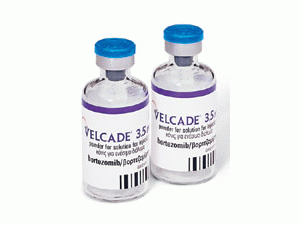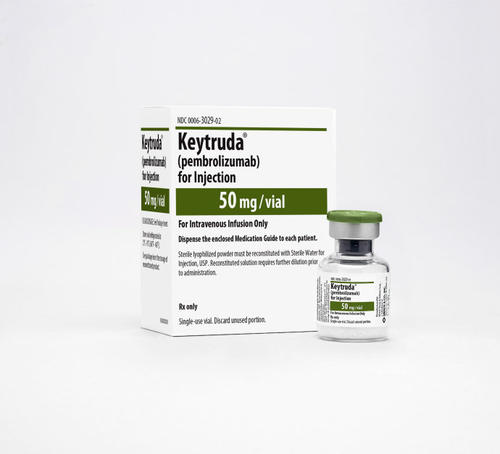万珂冻干粉注射剂(VELCADE Injection 3mg)
 产地国家:日本
产地国家:日本
处方药:是
所属类别: 3.毫克/瓶
包装规格: 3.毫克/瓶
计价单位:瓶
生产厂家英文名:Janssen Pharmaceutica
原产地英文商品名:VELCADE INFUSION(ベルケイド注射用)3.mg/Vial
原产地英文药品名:BORTEZOMIB
中文参考商品译名:万珂注射用粉剂(ベルケイド注射用)3.毫克/瓶
中文参考药品译名:硼替佐米
简介:
部份中文万珂处方资料(仅供参考)
治疗类别名称:抗肿瘤药(蛋白酶抑制剂)
商标名:VELCADE Injection
一般名:ボルテゾミブ(JAN)、Bortezomib(JAN)
化学名:{(1R)-3-Methyl-1-[(2S)-3-phenyl-2-(pyrazine-2-carboxamido)propanamido]butyl}boronic acid
分子式:C19H25BN4O4
分子量:384.24
化学构造式性状:白色至淡黄白色粉末或质量可溶性微溶于2-丙醇或乙腈。分配系数K0=100.87(pH为1〜8)K1<0.1(PH8.5以上)(1-辛醇/水)操作注意事项包装开封后还可以存储在黑暗中,并把该小瓶在一个盒子里。批准条件在建立药品风险管理计划的顶部,要正确实施。
适应病症:多发性骨髓瘤套细胞淋巴瘤
用法用量:
1. 未经治疗的多发性骨髓瘤成人每天为1.3mg/平方米(体表面积),4,8,11,22,25,29,32天进静脉组合和内部管理或皮下给药,10天冲刷(33-42天)。 6周为一个周期,重复给药多达4次。 5个循环后,每天一次,1,8,22,静脉内或皮下29天给药的第13天的洗脱(30-42天)。六周为一个周期,重复给药多达9个周期。该药物是待施用相隔至少72小时。
2. 复发或难治性多发性骨髓瘤成人一天为静脉内为1.3mg/平方米(体表面积),每周两次,如硼替佐米,2周(1,4,8,11天),10天的洗脱(12至21日)到。这种三周为一个周期,重复所述施用。该药物是待施用相隔至少72小时。或如果所述周期是连续施用超出将继续施用由上述剂量方案,或每周一次作为维持治疗4周(1,8,15,第22天)静脉内或皮下施用13天后冲洗(23-35天)。五周为一个周期,重复所述施用。
3.套细胞淋巴瘤与其它抗肿瘤剂,一次11天,每天为成人,1为1.3mg/平方米(体表面积),4,8,静脉内给药后,10天假日组合医学(12〜21天)。这种三周为一个周期,(最多8个周期,如果在第六个周期中观察到的第一个反应)至多6个周期的重复的施用。该药物是待施用相隔至少72小时。顺便提及,当静脉内给药是困难的,它也可以被皮下给药。
药效药理:药理作用硼替佐米,在体外研究中,人骨髓瘤衍生的RPMI8226和U266细胞系,从SP53,MINO,格兰特519和Jeko-1细胞系衍生的人套细胞淋巴瘤,以及从患者的套细胞淋巴瘤分离多发性骨髓瘤和肿瘤细胞生长抑制诱导细胞凋亡。此外,阿霉素,显示了对米托蒽醌的抑制作用,骨髓瘤细胞系变得马法兰或地塞米松抗性。
作用机序:(1) 硼替佐米,通过抑制肿瘤细胞的蛋白酶,诱导凋亡抑制其生长。(2) 硼替佐米抑制转录因子NF-κB来控制细胞的增殖和细胞凋亡的激活。(3) 硼替佐米,通过抑制NF-κB的活化,抑制骨髓瘤细胞与骨髓基质细胞的粘附,抑制细胞因子的分泌,如IL-6,它抑制骨髓瘤细胞的生长。包装规格万珂注射用:3毫克:1瓶制造厂商杨森制药有限公司。
英文版说明书:
VELCADE(Bortezomib Injection)Indications and Important Safety Information for VELCADE® (bortezomib)INDICATIONS:VELCADE (bortezomib) is indicated for the treatment of patients with multiple myeloma and patients with mantle cell lymphoma.CONTRAINDICATIONS:VELCADE is contraindicated in patients with hypersensitivity (not including local reactions) to bortezomib, boron, or mannitol, including anaphylactic reactions. VELCADE is contraindicated for intrathecal administration. Fatal events have occurred with intrathecal administration of VELCADE.WARNINGS AND PRECAUTIONSVELCADE (bortezomib) is for subcutaneous or IV administration only. Because each route of administration has a different reconstituted concentration, caution should be used when calculating the volume to be administered.Peripheral neuropathy, including severe cases, may occur. Patients should be monitored for symptoms and managed with dose modification or discontinuation. Patients with preexisting symptoms may experience worsening peripheral neuropathy (including ≥Grade 3). Starting with VELCADE subcutaneously may be considered for patients who either have preexisting or are at high risk for peripheral neuropathy.Hypotension:Caution should be used when treating patients receiving antihypertensives, those with a history of syncope, and those who are dehydrated.Cardiac toxicity, including acute development or exacerbation of congestive heart failure and new onset of decreased left ventricular ejection fraction, has occurred. Isolated cases of QT-interval prolongation have been reported. Patients with risk factors for, or existing, heart disease should be closely monitored.Pulmonary toxicity:Acute respiratory distress syndrome (ARDS) and acute diffuse infiltrative pulmonary disease of unknown etiology have occurred (sometimes fatal). Pulmonary hypertension, in the absence of left heart failure or significant pulmonary disease, has been reported. In the event of new or worsening cardiopulmonary symptoms, consider interrupting VELCADE until a prompt and comprehensive diagnostic eva luation is conducted.Posterior reversible encephalopathy syndrome has occurred. Consider MRI imaging for onset of visual or neurological symptoms; discontinue VELCADE if suspected.Gastrointestinal toxicity, including nausea, diarrhea, constipation, and vomiting, has occurred and may require use of antiemetic and antidiarrheal medications or fluid replacement. Interrupt VELCADE (bortezomib) for severe symptoms.Thrombocytopenia/Neutropenia:Manage with dose and/or schedule modifications. Complete blood counts should be monitored frequently during treatment. There have been reports of gastrointestinal and intracerebral hemorrhage. Support with transfusions and supportive care, according to published guidelines.Tumor lysis syndrome:Closely monitor patients with high tumor burden and take appropriate precautions.Hepatic toxicity:Monitor hepatic enzymes during treatment. Upon occurrence, interrupt therapy with VELCADE to assess reversibility.Embryo-fetal risk:Women should avoid breast-feeding or becoming pregnant while on VELCADE.Patients with diabetes may require close monitoring and adjustment of the antidiabetic medications.DRUG INTERACTIONS:Closely monitor patients receiving VELCADE (bortezomib) in combination with strong CYP3A4 inhibitors. Avoid concomitant use of strong CYP3A4 inducers.ADVERSE REACTIONSPreviously untreated multiple myeloma (MM): In the phase 3 study of VELCADE administered intravenously with melphalan and prednisone (MP) vs MP alone, the most commonly reported adverse reactions (ARs) were thrombocytopenia (48% vs 42%), neutropenia (47% vs 42%), peripheral neuropathy (46% vs 1%), nausea (39% vs 21%), diarrhea (35% vs 6%), neuralgia (34% vs <1%), anemia (32% vs 46%), and leukopenia (32% vs 28%).Relapsed MM subcutaneous vs IV: In the phase 3 study of VELCADE (bortezomib) administered subcutaneously vs intravenously in relapsed MM, safety data were similar between the two treatment groups. The most commonly reported ARs in the subcutaneous vs IV treatment groups were peripheral neuropathy (37% vs 50%) and thrombocytopenia (30% vs 34%). The incidence of serious ARs was similar in the subcutaneous treatment group (20%) and the IV treatment group (19%). The most commonly reported serious ARs were pneumonia and pyrexia (each 2%) in the subcutaneous treatment group and pneumonia, diarrhea, and peripheral sensory neuropathy (each 3%) in the IV treatment group.Previously untreated mantle cell lymphoma (MCL): In a phase 3 study of VELCADE administered intravenously with rituximab, cyclophosphamide, doxorubicin, and prednisone (VR-CAP) vs vincristine, rituximab, cyclophosphamide, doxorubicin, and prednisone (R-CHOP), the most commonly reported ARs were neutropenia (87% vs 71%), thrombocytopenia (72% vs 17%), leukopenia (48% vs 36%), anemia (44% vs 29%), lymphopenia (28% vs 12%), peripheral neuropathy (30% vs 27%), diarrhea (25% vs 5%), nausea (23% vs 12%), and pyrexia (20% vs 10%).Relapsed MM and MCL: In the integrated analysis of 1163 patients in phase 2 and 3 studies of VELCADE administered intravenously, the most commonly reported ARs were nausea (49%), diarrhea NOS (46%), fatigue (41%), peripheral neuropathy NEC (38%), and thrombocytopenia (32%). A total of 26% of patients experienced serious ARs. The most commonly reported serious ARs included diarrhea, vomiting, and pyrexia (each 3%); nausea, dehydration, and thrombocytopenia (each 2%); and pneumonia, dyspnea, peripheral neuropathies NEC, and herpes zoster (each 1%).
药品价格查询,专业药品查询网站,药品说明书查询,药品比价 » 万珂冻干粉注射剂(VELCADE Injection 3mg)






